Age influences susceptibility of brain capillary endothelial cells to La Crosse virus infection and cell death
- PMID: 34082753
- PMCID: PMC8173794
- DOI: 10.1186/s12974-021-02173-4
Age influences susceptibility of brain capillary endothelial cells to La Crosse virus infection and cell death
Abstract
Background: A key factor in the development of viral encephalitis is a virus crossing the blood-brain barrier (BBB). We have previously shown that age-related susceptibility of mice to the La Crosse virus (LACV), the leading cause of pediatric arbovirus encephalitis in the USA, was associated with the ability of the virus to cross the BBB. LACV infection in weanling mice (aged around 3 weeks) results in vascular leakage in the olfactory bulb/tract (OB/OT) region of the brain, which is not observed in adult mice aged > 6-8 weeks. Thus, we studied age-specific differences in the response of brain capillary endothelial cells (BCECs) to LACV infection.
Methods: To examine mechanisms of LACV-induced BBB breakdown and infection of the CNS, we analyzed BCECs directly isolated from weanling and adult mice as well as established a model where these cells were infected in vitro and cultured for a short period to determine susceptibility to virus infection and cell death. Additionally, we utilized correlative light electron microscopy (CLEM) to examine whether changes in cell morphology and function were also observed in BCECs in vivo.
Results: BCECs from weanling, but not adult mice, had detectable infection after several days in culture when taken ex vivo from infected mice suggesting that these cells could be infected in vitro. Further analysis of BCECs from uninfected mice, infected in vitro, showed that weanling BCECs were more susceptible to virus infection than adult BCECs, with higher levels of infected cells, released virus as well as cytopathic effects (CPE) and cell death. Although direct LACV infection is not detected in the weanling BCECs, CLEM analysis of brain tissue from weanling mice indicated that LACV infection induced significant cerebrovascular damage which allowed virus-sized particles to enter the brain parenchyma.
Conclusions: These findings indicate that BCECs isolated from adult and weanling mice have differential viral load, infectivity, and susceptibility to LACV. These age-related differences in susceptibility may strongly influence LACV-induced BBB leakage and neurovascular damage allowing virus invasion of the CNS and the development of neurological disease.
Keywords: Blood-brain barrier; Brain capillary endothelial cells; Cytopathic effect; La Crosse virus; Vascular leakage.
Conflict of interest statement
The authors declare that they have no competing interests.
Figures
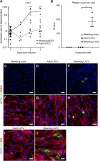

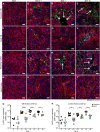

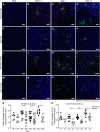
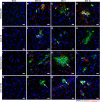
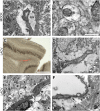
Similar articles
-
Age-specific dynamics of neutralizing antibodies, cytokines, and chemokines in response to La Crosse virus infection in mice.J Virol. 2024 Dec 17;98(12):e0176224. doi: 10.1128/jvi.01762-24. Epub 2024 Nov 5. J Virol. 2024. PMID: 39498968 Free PMC article.
-
Age-dependent myeloid dendritic cell responses mediate resistance to la crosse virus-induced neurological disease.J Virol. 2014 Oct;88(19):11070-9. doi: 10.1128/JVI.01866-14. Epub 2014 Jul 9. J Virol. 2014. PMID: 25008929 Free PMC article.
-
Capillaries in the olfactory bulb but not the cortex are highly susceptible to virus-induced vascular leak and promote viral neuroinvasion.Acta Neuropathol. 2015 Aug;130(2):233-45. doi: 10.1007/s00401-015-1433-0. Epub 2015 May 9. Acta Neuropathol. 2015. PMID: 25956408
-
Innate immune response to La Crosse virus infection.J Neurovirol. 2014 Apr;20(2):150-6. doi: 10.1007/s13365-013-0186-6. Epub 2013 Jul 12. J Neurovirol. 2014. PMID: 23846288 Review.
-
La Crosse Virus: A Comprehensive Review of Its Emerging Public Health Importance.Viral Immunol. 2025 May;38(4):137-147. doi: 10.1089/vim.2024.0088. Epub 2025 Apr 24. Viral Immunol. 2025. PMID: 40274395 Review.
Cited by
-
Identification of age-specific gene regulators of La Crosse virus neuroinvasion and pathogenesis.Nat Commun. 2023 May 18;14(1):2836. doi: 10.1038/s41467-023-37833-x. Nat Commun. 2023. PMID: 37202395 Free PMC article.
-
Molecular epidemiology and pathogenicity of Wesselsbron virus circulating in Africa.Virus Res. 2024 Dec;350:199499. doi: 10.1016/j.virusres.2024.199499. Epub 2024 Nov 17. Virus Res. 2024. PMID: 39547415 Free PMC article.
-
An Overview of La Crosse Virus Disease.Neurohospitalist. 2022 Jul;12(3):587-588. doi: 10.1177/19418744221077738. Epub 2022 Feb 28. Neurohospitalist. 2022. PMID: 35755222 Free PMC article. No abstract available.
-
Targeted Mutations in the Fusion Peptide Region of La Crosse Virus Attenuate Neuroinvasion and Confer Protection against Encephalitis.Viruses. 2022 Jul 2;14(7):1464. doi: 10.3390/v14071464. Viruses. 2022. PMID: 35891445 Free PMC article.
-
Development of an RT-RPA assay for La Crosse virus detection provides insights into age-dependent neuroinvasion in mice.Virol J. 2025 Apr 9;22(1):95. doi: 10.1186/s12985-025-02720-y. Virol J. 2025. PMID: 40205618 Free PMC article.
References
MeSH terms
Substances
Grants and funding
LinkOut - more resources
Full Text Sources
Medical
Research Materials
Miscellaneous

